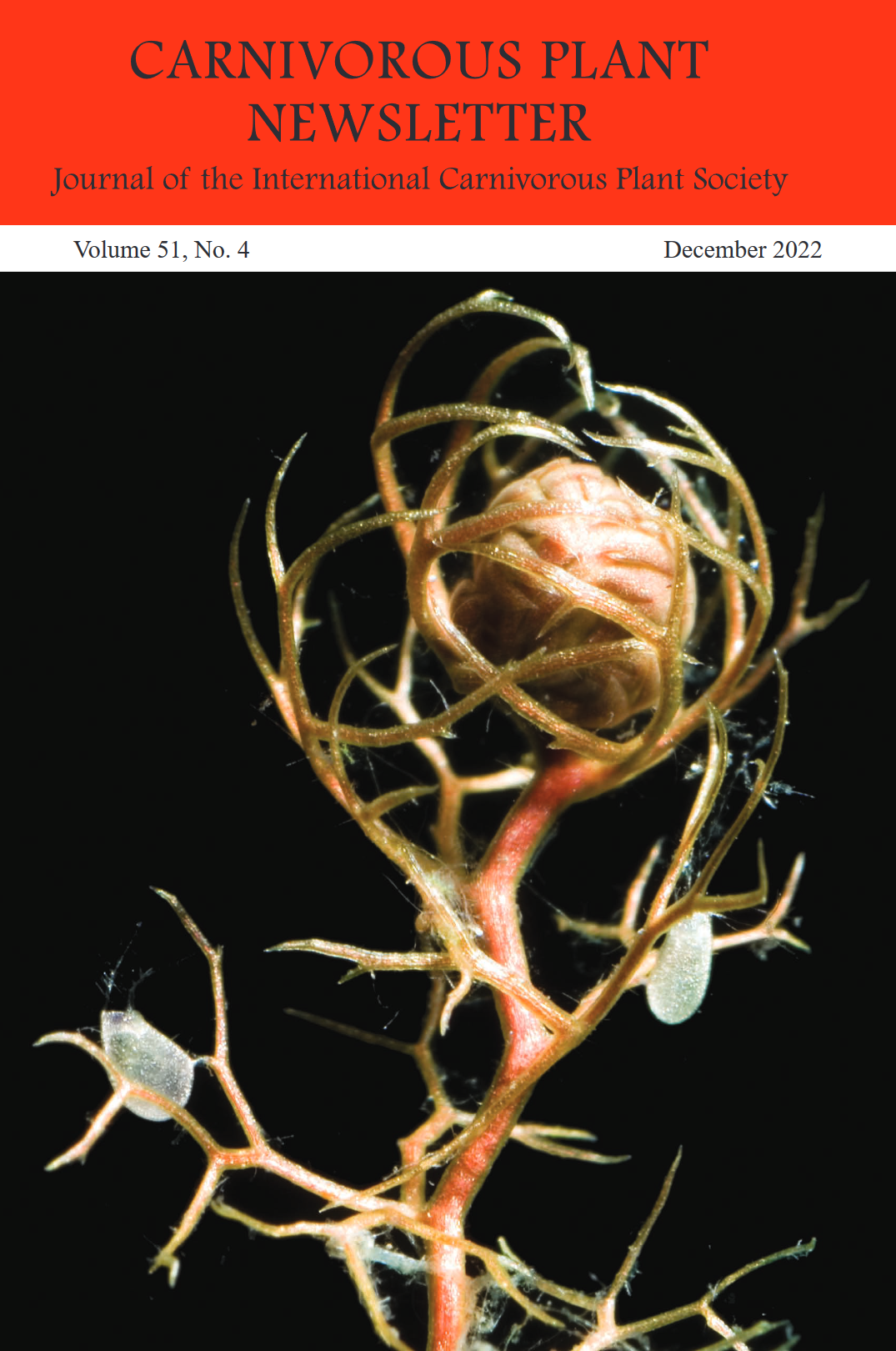|
 The taxonomic relevance of Naphthoquinones in tropical pitcher plants (Nepenthes L., Nepenthaceae) The taxonomic relevance of Naphthoquinones in tropical pitcher plants (Nepenthes L., Nepenthaceae)
Jan Schlauer, Andreas Wistuba, Siegfried R. H. Hartmeyer and Irmgard Hartmeyer.
https://doi.org/10.55360/cpn514.js802.
Keywords: Nepenthes, phytochemistry, naphthoquinones, chemotaxonomy.
Jetzt verfügbar / now available: Der vollständige Text / Full text (PDF)

Abstract:
The distribution of the naphthoquinones ramentaceone and plumbagin was studied among
50 taxa of the genus Nepenthes.
Naphthoquinone patterns support classifications based on homology of
plastid and/or nuclear genes to some extent, with plumbagin predominant
in sections Nepenthes, Urceolatae, Tentaculatae, and Regiae, ramentaceone predominant in sections Insignes and Villosae, and both isomers present without clear predominance in sections Pyrophytae and Montanae.
Only 9 of 96 studied species contained both isomers in the same plant.
Naphthoquinone data from artificial hybrids of known parentage allowed
conclusions on the biosynthesis of these compounds and the heredity of
the respective enzymatic steps. |
References:
Aung, H.H., Chia, L.S., Goh, N.K., Chia, T.F., Ahmed, A.A., Pare, P.W., and Mabry, T. J. 2002.
Phenolic constituents from the leaves of the carnivorous plant Nepenthes gracilis. Fitoterapia
73: 445-447. https://doi.org/10.1016/S0367-326X(02)00113-2
Clarke, C., Schlauer, J., Moran, J., and Robinson, A. 2018. Systematics and evolution of Nepenthes.
In: Ellison, A.M. and Adamec, L.; eds. Carnivorous Plants: Physiology, Ecology, and Evolution.
Oxford University Press, pp. 58-69. https://doi.org/10.1093/oso/9780198779841.003.0005
Culham A., and Gornall, R.J. 1994. The taxonomic significance of naphthoquinones in the Droseraceae.
Biochem. System. Ecol. 22: 507-515. https://doi.org/10.1016/0305-1978(94)90045-0
Heubl, G., and Wistuba, A. 1998. A cytological study of the genus Nepenthes L. (Nepenthaceae).
Sendtnera 4: 169-174. https://www.zobodat.at/pdf/Sendtnera_4_0169-0174.pdf
Hoshi, Y., and Kondo, K. 1998. Chromosome differentiation in Drosera, subgenus Rorella, section
Rossolis. Cytologia 63: 199-211. https://doi.org/10.1508/cytologia.63.199
James, S.H., Chen, L., Lowrie, A., and Marchant, N. 1997. Chromosome counts. (pp. 192-193)
in Chen, L., James, S.H., and Helen M. Stace, H.M., Self-incompatibility, seed abortion and
clonality in the breeding systems of several western Australian Drosera species (Droseraceae).
Australian Journal of Botany 45: 191-201. https://doi.org/10.1071/BT96027
Kondo, K., and Lavarack, P.S. 1984. A cytotaxonomic study of some Australian species of Drosera L.
(Droseraceae). Bot. J. Linn. Soc. 88: 317-333. https://doi.org/10.1111/j.1095-8339.1984.tb01579.x
Volume 51 December 2022 193
Kondo, K., and Segawa, M. 1988. A cytotaxonomic study in artificial hybrids between Drosera anglica
Huds. and its certain closely related species in series Drosera, section Drosera, subgenus
Drosera, Drosera. La Kromosomo II-51-52: 1697-1709.
Likhitwitayawuid, K., Kaewamatawong, R., Ruangrungsi, N., and Krungkrai, J. 1998.
Antimalarial naphthoquinones from Nepenthes thorelii. Planta Medica 64: 237-241.
https://doi.org/10.1055/s-2006-957417
Rischer H., Hamm, A., and Bringmann, G. 2002. Nepenthes insignis Danser (Nepenthaceae)
uses a C2-portion of the carbon skeleton of alanine acquired via its carnivorous
organs to build up the allelochemical plumbagin. Phytochemistry 59: 603-609.
https://doi.org/10.1016/S0031-9422(02)00003-1
Rivadavia, F. 2005. New chromosome numbers for Drosera L. (Droseraceae). Carniv. Pl. Newslett.
34: 85-91. https://doi.org/10.55360/cpn343.fr964
Scharmann, M., Wistuba, A., and Widmer, A. 2021. Introgression is widespread in the radiation
of carnivorous Nepenthes pitcher plants. Molecular Phylogenetics and Evolution 163: 107214.
https://doi.org/10.1016/j.ympev.2021.107214
Schlauer, J., and Fleischmann, A. 2016. Chemical evidence for hybridity in Drosera (Droseraceae).
Biochem. Syst. Ecol. 66: 33-36. https://doi.org/10.1016/j.bse.2016.03.005
Schlauer, J., and Fleischmann, A. 2021. Naphthoquinones in Pygmy Sundews (Drosera sect. Bryastrum).
Carniv. Pl. Newslett. 50: 111-117. https://doi.org/10.55360/cpn503.js430
Schlauer, J., and Fleischmann, A. 2022. Refined taxon sampling discloses new quinone patterns
and relationships among Sundews (Drosera, Droseraceae). Carniv. Pl. Newslett. 51: 70-73.
https://doi.org/10.55360/cpn511.js500
Schlauer, J., Nerz, J., and Rischer, H. 2005. Carnivorous plant chemistry. Acta Botanica Gallica
152: 187-195. https://doi.org/10.1080/12538078.2005.10515469
Schlauer, J., Hartmeyer, S.R.H., and Hartmeyer, I. 2017. Unexpected discovery of
7-methyljuglone (ramentaceone) in several Australian sundews. Carniv. Pl. Newslett. 46: 20-
22. https://doi.org/10.55360/cpn461.js140
Schlauer, J., Hartmeyer, S.R.H., Hartmeyer, I., Hennern, H., and Hennern, A. 2018. Sundew chemistry
and emergence updates. Carniv. Pl. Newslett. 47: 10-17. https://doi.org/10.55360/cpn471.js326
Schlauer, J., Carow, T., and Fleischmann, A. 2019a. Quinones from “Gondwanan” Sundews; Carniv.
Pl. Newslett. 48: 13-17. https://doi.org/10.55360/cpn481.js693
Schlauer, J., Hartmeyer, S.R.H., Hartmeyer, I., Hennern, H., and Hennern, A. 2019b. New sundew quinone
and emergence data. Carniv. Pl. Newslett. 48: 6-12. https://doi.org/10.55360/cpn481.js742
Schlauer, J., Hartmeyer, S.R.H., and Hartmeyer, I. 2019c. Quinone patterns and identification of
Japanese spider leg sundews (Drosera sect. Arachnopus). Carniv. Pl. Newslett. 48: 161-163.
https://doi.org/10.55360/cpn484.js448
Shin, K.-S., Lee, S.-K., and Cha, B.-J. 2007. Antifungal activity of plumbagin purified from leaves
of Nepenthes ventricosa × maxima against phytopathogenic fungi. The Plant Pathology Journal
23(2): 113-115. https://doi.org/10.5423/PPJ.2007.23.2.113
|
|